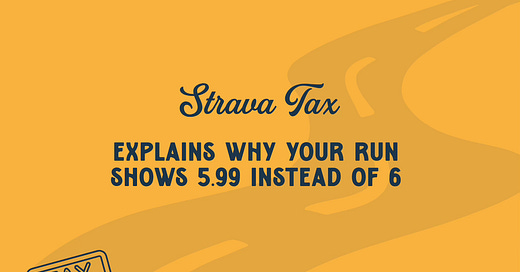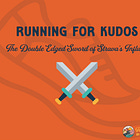"Strava Tax" Explains Why Your Run Shows 5.99, Instead of 6
It's not a bug. It's intentional and here's why Strava does it.
Triple Threat Life is an email newsletter with practical triathlon tips and mindset techniques to help everyday athletes succeed. Some installments are free. Some benefits are for paid subscribers only. Sign up here.
We all have to pay taxes.
Even athletes.
But I’m not talking about a 1099 or a W-2.
Consider this.
You finish a great workout, and your watch says you ran 6 miles. Not too shabby! You’re feeling particularly proud of your effort, only to look at Strava and see 5.99 miles instead.
This is a phenomenon known as “Strava Tax.”
And for those of us who love nice, round numbers, it can be infuriating!
Today, we’re explaining why this happens, the techie bits behind Strava’s upload system, and what to do if you desperately need to see a round number on your workout.
What’s Strava?
Strava is part fitness tracking platform, part social media network for athletes. It allows users to track runs, rides, swims, hikes, and a host of outdoor activities. (There are 30 different activities to choose from.)
Strava users can upload workouts, which include details like mileage and pace, as well as physiological information like calories burned and heart rate. You can add pictures and video. You can give “kudos” by liking a post or leaving a comment.
The app also has virtual competitions with leaderboards and trophies that are awarded for personal bests or fast times on specific segments.
And it’s very popular. Since 2009, Strava has accumulated over 100 million users.
What’s Strava Tax?

Now it isn’t a tax, per se. Strava isn’t taking a portion of your workout to help fund their security, education, or healthcare programs. It’s just a cheeky term they came up with to explain why workouts uploaded to Strava often show different mileage than what’s on your watch or bike computer.
This happens because Strava rounds down distances when displaying data.
Why? According to Strava, they make an effort to record each activity as “accurately and authentically” as possible. So they show what was recorded, down to the second decimal point.
But if your watch says 6 miles, why does Strava show 5.99?
This is because many devices actually round up when displaying distances, while Strava does the opposite. For example, even if your watch displayed 6 miles, the actual distance might have been 5.993. When that workout gets uploaded to Strava, it shows 5.99.
One reason this happens is because many devices adjust the mile split just slightly. For example, they might use 1609 meters for 1 mile, instead of the more precise 1609.344 meters. That skews the final distance.
Also, distances vary between brand and manufacturer. For example, if you were to wear a Garmin watch on one wrist and an Apple Watch on the other, they might display slightly different distances for the same workout.
Why doesn’t Strava just round up, like devices do?
Here’s what they had to say:
“We’re the hub that connects Garmin to Apple to COROS to Suunto to your community- and we must be fair and neutral in how we treat that data. That’s why we don’t adjust the raw distance we receive. We don’t add a buffer. We don’t try to reverse-engineer your tracker’s optimism or correct them on a device-by-device basis. We display the exact number that came in, rounded down, to reflect the most authentic, reliable version of the truth.”
Inner workings: The techie bits
For those who love the inner workings of data collection, here’s how activities get uploaded to Strava. Most activities come in a FIT file, which includes a list of distances in meters at different points in time, as well as a session value that should correspond to the last distance value, which summarizes the whole activity.
An important point to make is that Strava assumes the first distance point in your workout is 0.0, although that might not be the case with every device. Also, Strava calculates the difference between the last point in the data stream and 0.0 to determine the final distance in meters, regardless of whether you have units set at imperial or metric.
For non-FIT devices, Strava ignores the distance provided by the device (because it’s often inconsistent) and recalculates the distance from the GPS file. Then, they round down two decimal places.
Why does Strava round down, and what can you do about it?
Apparently, when Strava started in early 2010, GPS wasn’t as reliable as it is today. Strava noticed that distances were often overestimated, so in 2012 they adopted the practice of rounding down.
Could they change it and start rounding up?
They could. But Strava explained that would involve altering almost six years worth of data files from millions of users. This could change leaderboards, challenges, and yearly recaps, and it doesn’t fall in line with their stated intention to be fair and neutral in how they treat data and to “reflect the most authentic, reliable version of the truth.”
They started the platform by rounding down, and it’s likely to stay that way for the foreseeable future.
So it’s not a Strava bug, and they aren’t trying to mess with your brain.
Ultimately, it doesn’t really matter if your run shows 5.99 or 6 miles, because you put in the time and did the work.
But if you’re one of those athletes who can’t stand not seeing a round number, you may need to run until your watch shows 6.01. Then it will display how you want on Strava.
This is probably a good time to provide a little perspective about social media networks, because that’s what Strava is. While these platforms can be fun, because they provide community, accountability, and help you track progress towards goals, there’s a darker side that can come along with it.
When Strava, or any social media, is used for unnecessary comparison, purposeful exclusion, bullying, or makes you feel worse about yourself, it’s time to take a break. If you find yourself altering your workouts because of how they appear on Strava, that’s a big red flag that you’re taking it a bit too seriously.
Social media isn’t real life. It’s a reflection of life. Live in the real world. Not online.
Here’s the truth: Nobody really cares what your workout looks like. They’re more preoccupied with what other people think about their workout. So take it with a grain of salt.
If you’re interested in reading more, few months back, I wrote this piece- Running For Kudos: The Double-Edged Sword of Strava’s Influence- which looks at a 2022 study that examined the perceived psychosocial implications of Strava use on collegiate runners.
Tri Smarter, Not Harder e-book
Download your copy of the new Tri Smarter, Not Harder e-book today.
It’s a no-fluff, real-world guide to training smarter, racing faster, and avoiding the mistakes most triathletes make. With sections for swim, bike, run, transition, and nutrition, learn 50 essential strategies to tri smarter, not harder.
*Paid subscribers get the e-book for FREE! Sign up today to get a copy and to take advantage of our monthly expert video chats and discount list.
News & Notes
My friends did so great at their race! Claire, Mack, and Diane were all on the podium in their age groups at 70.3 Des Moines! Yay ladies! Also, pro triathlete, Grace Alexander, placed 3rd! If you missed our monthly expert meeting with Grace last week, here’s a link to the accompanying blog post.
This past weekend was 1,000% humidity here in Florida, but we made the best of it with a 3-hour bike ride to the lighthouse and recovery snacks. I made a blackberry cobbler, and it was delicious. Also, the kitties we rescued Memorial Day weekend are doing great! They’re almost 10 weeks old now and love playing, eating, and purring.




This week is my birthday! And it’s a big one, so Matt and I are headed off on a mini-vacation. I have a fun post coming out Thursday with a gift for you, so stay tuned…
Apparently, Triple Threat Life is now listed as 54th in Substack’s rising sports list, so yay! I don’t really know what that means, but considering this little triathlon blog is on a list with blogs about football, soccer, hockey, and golf, I’d say it’s a good thing. That’s all thanks to you guys, so if you enjoy what you read, please consider sharing with a friend.








